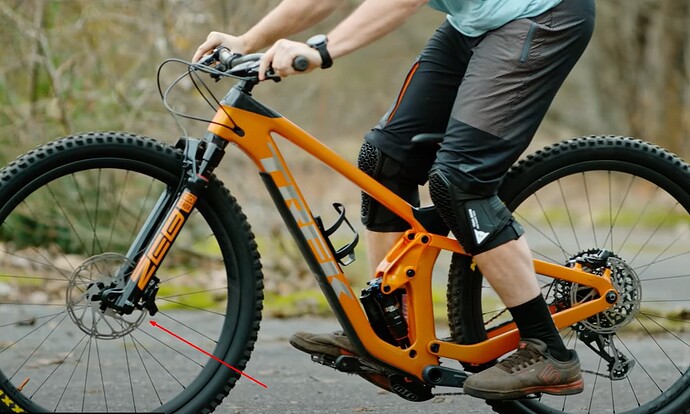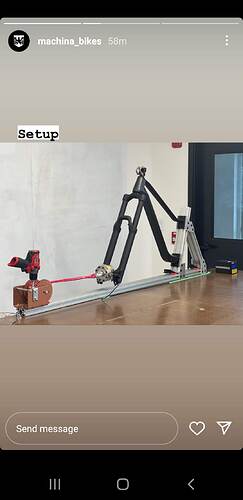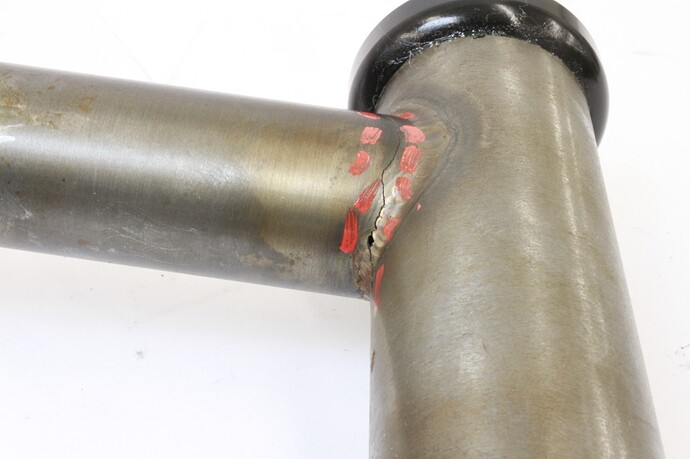That’s excellent data and pretty much settles it for me. LOL
Can you elaborate on this a bit? I have not run FEA and don’t know how it goes so I’m not sure I understand. What butt thickness did you use and butt length to compare to a gusset setup? There are so many variations on these variables I don’t know how to generalize. I learned that the biggest impact on strength is butt length, not butt wall thickness. This is why you see so many Columbus MTB tubes with thinner walls but long butts on one end (I.e., Zona). Maybe that’s old data from when frames were smaller sized and didn’t have such high travel forks?
Also, I’ve always seen the top tube gusset on top of the top tube, not sure if I’m seeing it right but yours looks to be on the bottom?
Thats a good point on the gusset placement. Also Dan, in the model were you able to weld the sides of the gusset and have the end open? Or is it just the plate sitting against the tube. In my mind Im still in the design appropriate butts and ingore gussets.
I always thought of gussets as a way to make your own butted tube from straightgauge, not a way to reinforce butted tubing. If I want a stronger joint using butted tubing, I’ll use longer/thicker butts.
I guess I’ve not really seen any/many failures where I think a gusset would have helped, and I’ve seen plenty of frames buckle right at the end of the gusset, just like I’ve seen them buckle at the ramp to the thin section.
-Walt
The generalizations I made came from my experiences playing around with different gussets and butts. Its a bigger picture conclusion rather than individual analysis
The picture I just showed was:
- TT: 28.6-969,
- DT: 38.1-969
- Gusset: .9 thk
I think the long butt should definitely be placed at the HT end. The real-world failures and FEA support this. When I said the butt location and length were unremarkable, I was referring to two tubes that had the same butts, but slightly different butt lengths (ie. Tange vs Zona DT). The 50-100mm difference in the butt lengths had minimal impact on the stiffness of the frame.
In comparison, going from a .5 to a .7 butt has a much bigger impact.
This gusset is modeled as if were perfectly attached to the tube. I think this is testing the best-case scenario. In the real world, there would be stress concentration and HAZ from welding.
That is a good point. I feel like the gusset discussion is very similar to the Willis brake mount failues. Adding more material to spread out the load makes sense in theory, but in reality, it could just be adding stress risers, more HAZ, or relocating the force to a thinner part of the tube.
Without real-world test data, it would be hard to definitively answer the gusset question. But at best, the FEA says it’s a minor improvement.
@Daniel_Y This FEA is great information to have and be seen!
But I think a few data points are missing to get the whole picture.
- What is the direction of the loading in the model and where is the load applied?
- Are you following the loads/vectors from the ISO standards? Or some other values?
I know that a lot of the larger brands develop their own testing standards that go beyond what ISO recommends. The ISO standard should be seen as the minimum standard a frame should hit to be sellable internationally. That said, a bike designed for XC and a DH bike are intended for very different loadings and are optimized for their use cases.
- It would be cool to see this sim as a remote load out at the fork dropouts instead of the headset cup.
To @Meriwether 's point about gusset on top or bottom of the TT, there’s the ‘running into a curb’ test (ISO) but also the opposite splay case (harsh bottom out, front axle bending away from the frame)
The sim is very very naive: 100N was applied at the bottom headset.
The classic quote “all models are wrong, some are useful” applies. I don’t use FEA for “no, no-go” decisions. I use it to inform my intuition and provide some analytical basis for my decision-making. That is why I encourage people to form their own conclusions.
I would love to build a test lab to validate all the forces and FEA, but then I would be a legit bike company ![]()
This article from POLE bikes is the only place I have seen that shares the test numbers for the EFBE TRI-TEST Cat 5. This is downhill bike level test numbers. The set-up here would be good to incorporate into any FEA testing on where to apply loads.
We could have a full thread on gussets obviously but I think we’re all on the same page for the most part.
I’ve used them when I thought a frame needed it, because the downtube choices were not great for a few years after True Temper closed, Variwall started but had nothing in stock, and bikes were getting longer and slacker. Same reason BMX used them on straight gauge (to create a butted tube in a sense).
I’d add the gusset as a “band aid” to a 9/6/9 to make my own sort of “DZB” downtube before Reynolds made them. With the right technique of welding on the sides and having a gap between the gusset and tubes it should strengthen it, but yeah…it does potentially add a stress riser at the points. However the gusset should end on the thick butt, well before the butt transition.
In the last year I’ve seen Firefly use a fully welded gusset on Ti MTB’s. Without butted Ti tubes I get this sentiment. Those guys know their stuff so I would like to know if any testing was done before they sold frames this way? Doubt they’re on the forum but if anyone knows that’d be a good datapoint.
Has anybody on here had a frame tested at EFBE? I would love to know how one of mine would do and where it would fail.
How does the insurance work for small framebuilders without any standardized testing like EFBE?
@Daniel_Y
No worries! That’s a great way to use FEA as a gut check.
Aren’t we all legit bike companies, coming together to make a super bike company with many heads? ![]()
How cool could it be for the community to understand production company levels, accept the short comings, and optimize for the individuals? This forum is awesome!
@Bucko I would also be curious what lab testing any one has done.
I have 2 friends that went to EFBE for work. One is a filmer and the other is an engineer. It was interesting to hear about how some frames broke the test bed and how they needed bigger/stronger components to realize the tests above the ISO standards. Certain companies have developed different tests that are specific to that company.
I’ll ask my engineer friend if he can share a bit more. He’s coming over today to machine some brake mounts.
Maybe we should start a thread specific to ISO standards and testing.
@Bucko does Scott have in-house testing? I know Rocky has a full compliment of test rigs here in North Van at their development center and I’ve thought of asking my friends there is they’ll put one of my frames through the paces so see how it does. Sending a frame all the way to Germany for the full EFBE is way out of my budget as a home gamer.
The guys at Machina had set up a fairly simple test rig to test their front end. This would be after they had a catastrophic failure on Matt Beer at WBP as he was reviewing the frame and had the headtube blow off.
Insurance doesn’t require testing, at least my agency doesn’t. They just ask for your sales figures and how many frames, forks, bikes, etc you build a year.
Testing custom frames isn’t realistic either IMO since for many custom builders every frame is a bit, or a lot, different with tube diameter, wall thickness, butt lengths, size.
Testing makes sense for production runs in bigger companies but I don’t personally know of any builders that have sent a frame away to get tested.
It’s a lot of $$ too which small builders usually don’t have.
I’m currently planning a test rig and frame similar to what Machina did for my mtb’s. They are a production bikes essentially so it’s worthy spending the time and money to ensure I am doing everything right. My road bikes tend to stick with tried and true construction and tubes weights so there is no value in testing that in my eye. If I was trying to push material limits by reducing mass then that’s a different scenario.
Yeah probably it needs it’s own thread.
No, we don’t have any testing at the HQ but we do testing at the factory and EFBE.
Specialized, Trek, Giant, Santa Cruz, Cervelo, and Scott all do in-house testing.
Most companies rely on factory support to test the frames. EFBE also has facilities in the US and TW. Otherwise ACT-Lab can do testing on a frame here in the states but the cost is not small.
For smaller brands, I think that Allied, Enve, (arguably small brands) and Argonaut are the only ones to do their own testing. Otherwise it’s the wild west.
@Meriwether does highlight a good point in that frame testing is good for mass production but not necessarily for custom frames. From a custom builder standpoint, testing can be done a handful of times to validate a new process or analysis methodology but testing for each new frame would require two frames to be built with one going to the customer and the other being destructively tested which isn’t exactly profitable.
That being said I’d love to test “all the things” but that’s a bit tricky to do for a small builder budget.
I switched from a 9/6/9 32mm TT and 32mm ST to an 8/5/8 35mm TT and 35mm 0.9mm ST with PMW collar because the original frame felt too noodly. However this is in the XXL size range with a long HT (170 to 190mm). Used a 38mm 1/.6/.8 Deda DT on the 2nd one and a similar Columbus Zona DT for the 1st one.
The 35mm ST/TT combo feels perfectly fine, not too stiff, not too flexy.
I have been wondering relatively how much the ST contributes to torsional rigidity vs the TT? Anybody have some insight?
Hi All, I’ve been reading through this thread with interest - I just had a prototype fail at the top tube during the EFBE horizontal load test (120kg max total weight, level 3 / XC MTB test - similar to ASTM 3
). The frame has a Reynolds 853 28.6mm 9/6/9 TT, a 853 DZB 34.9mm 1.1/.9/.6/9 DT, 140mm 36.4 mm /1.2 631 steer tube and a rigid 450mm fork. With the longish HT and shortish fork length I was hoping to get away without gussets and def thought the 853 tube would be strong enough but no such luck. It appears the crack originated in the weld on the underside of the TT/HT joint, so I’m thinking butt length, wall thickness were not the issue, but more due to a weld issue / HAZ? Or is 853 too brittle - guessing UTS was less a factor than ductility in this case? Any thoughts on root cause here and possible remedies (hoping not to have to use a gusset or 31.8 TT!) would be greatly appreciated. Many thanks in advance!
I dont know much but i would guess that the HT ideally shouldnt be too short to concentrate all the stress but otoh it being too long reduces stiffness too?
(if we are only talking about materials (or can isolate it as the dominant culprit:)
Interestingly enough @stevenshand mentioned he switched out 853 HT for 631 (same steel but not heat treated) and that enabled it to pass a front load test: Sean @DEVLINCC also shares the opinion that sometimes stiffness leads to stress as well (hope I paraphrased him right).
But yeah that makes me more wary of those heat treated super steel. Thought for example 953 - a maraging steel is deemed as " steels that possess superior strength and toughness without losing ductility". Sounds a bit too good to be true so I will double check Wikipedia on that one later…


